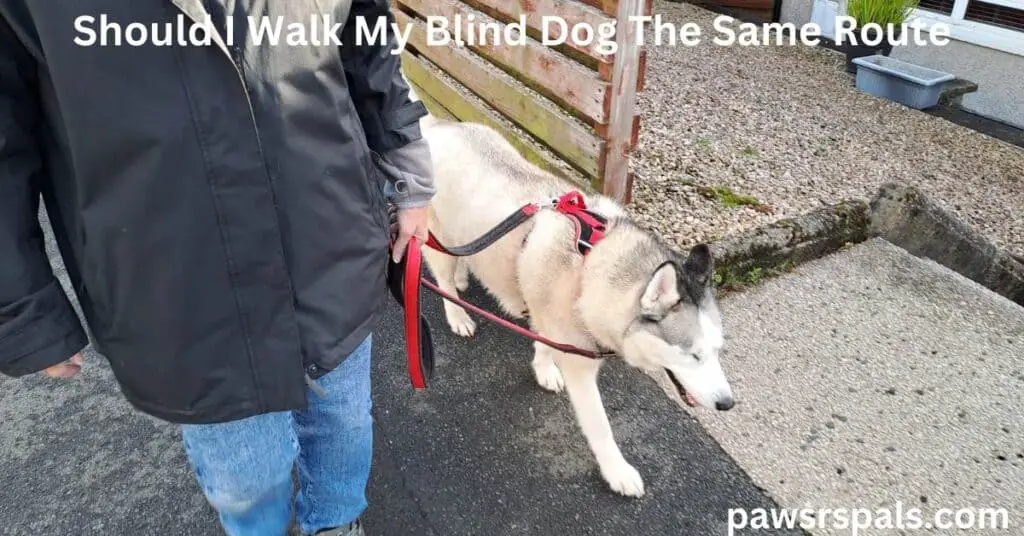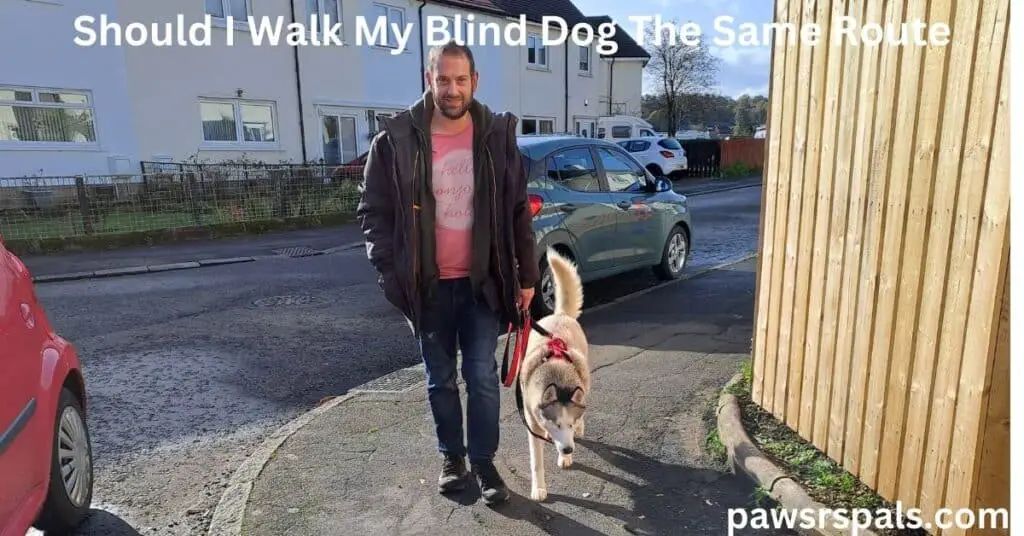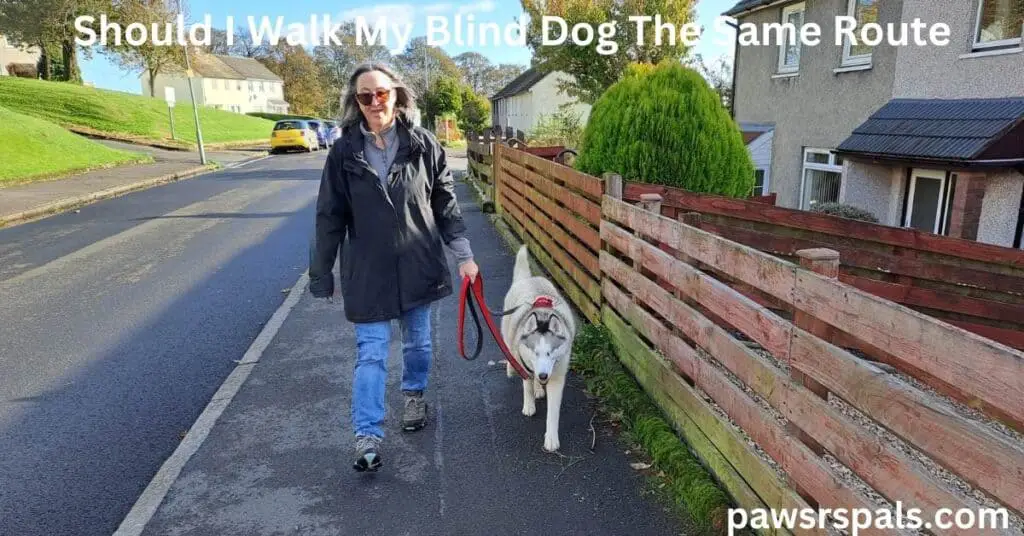Dogs enjoy a daily walk; it keeps them healthy and happy. But if your dog has gone blind, you might worry about how it will enjoy its daily walk. Walking a blind dog isn’t too different from walking a sighted dog. The main difference is that you are your dog’s eyes and have to guide them around obstacles.

Your blind dog will still enjoy walking with you and sniffing its environment. Continuing your dog’s daily walking routine will also reduce the risk of your dog becoming depressed. Walking and playing with your dog reassures them that life is still fun and it is still able to enjoy life with you.
If your dog suddenly loses sight, sticking to the same route will lessen your dog’s anxiety as they are already familiar with the path. Once your dog has adjusted to its blindness and feels more comfortable exploring different routes, change them. Always go at your dog’s pace to help build their confidence and set them up for success.
Is A Harness Better Than A Collar For Walking A Blind Dog
Generally, a harness is better for walking any dog, sighted or blind. A collar can cause damage to a dog’s throat, neck, and spine. A well-fitted Y-shaped harness puts no pressure on your dog’s neck, spine, or shoulder joints.

A Y-shaped 2-point harness with a double-ended lead is ideal for walking a blind dog as it allows you to gently guide the dog around obstacles and change directions. A harness and verbal directional cues will allow you and your dog to enjoy a safe walk.
What Directional Cues Should I Teach My Blind Dog
For your dog’s safety, it is essential to teach some verbal cues, such as:
- Stop – a good emergency stop is a top cue to learn for a blind dog.
- Slowly – I use this cue to give notice for an upcoming obstacle or change in terrain.
- Left.
- Right.
- Walk on – I use this cue to walk forward in the same direction.
- Backup – I use this cue as a reverse.
- Up Step.
- Down Step.
- Over – I use this cue if there is an obstacle to step over.
- Under – I use this cue if there is an obstacle to go under.
This list isn’t finite. Depending on where you are and where you walk your dog, you may encounter other cues that you need or want to teach your dog. Teaching these cues also keeps your dog’s mind active and strengthens your bond. Brain work is just as essential for a healthy dog as physical work. So as well as verbal cues, you can also teach touch cues to your dog alongside the verbal cues.
Using positive reinforcement training with your blind dog will also increase their confidence and allow them to want to expand their experiences, especially if your dog is struggling to adjust to the blindness. It also reassures your dog that you are happy with them.
Take the training at your dog’s pace; always use a cheerful, happy voice. Your dog’s other senses will heighten with the loss of their sight. Take advantage of their sense of smell and hearing to engage them in play to increase their confidence. Get them used to relying on their nose and ears to move around.
How Do I Walk A Blind Dog
Before attempting to walk your blind dog on a path or near a road, ensure that your dog responds to the cues. This may mean spending time at home teaching and reinforcing the cues before you go for your first walk. Don’t feel bad about missing walks for a little bit. Training and playing with your dog at home to build their confidence will be enough in the short term.
When you have your Y-shaped 2-point harness and double-ended lead, clip the lead to the front and back of the harness. This can take a bit of practice to get used to, but it is excellent for gently giving touch cues for obstacles and directional changes.
Some dogs may feel more confident if they hear you are near them. Falconry bells in your hand or pocket can reassure your dog that you are close and let them know exactly where you are.
I keep my blind Husky to the inside of the path; she prefers to sniff the walls and hedgerows on the inside of the paths. Go slow; allow your dog to sniff everything they want. By sniffing, your dog is building a mind map of its environment and the route that they are on.

Give the verbal cues in plenty of time for your dog to react. This is another good reason to go slow. You will have to get used to being your dog’s eyes and giving the cues in time. Give lots of praise; your blind dog will need lots of positive reassurance throughout the walk, especially if they are anxious.
Go at your dog’s pace; if they only want a 10-minute walk, head home when ready. The time will increase with their confidence and when they adjust to their new circumstances.
Final Thoughts on Walking a Blind Dog
My Husky has been blind for a year now (since October 2021). We were lucky that we knew she would go completely blind. When she was around two and a half years old, she was diagnosed with primary glaucoma. Luna had to have her eye removed in 2019, and the eye specialist told us that she would lose the other eye in a couple of years. So we used the time to start directional cue training. I honestly believe that it was the training that helped Luna adjust to blindness so quickly. The training was there, and we could carry on as usual for her.
Luna is a very confident blind Husky. Most people who see her don’t realize that she is blind until they see her up close. Luna is so responsive to her directional cues that she can still go off-lead, run, play with other dogs, and swim in a safe environment. We regularly go to new places for her to explore. You can see some of her adventures on our Facebook page Paws R Pals, youTube PawsRPals, and her PawsRPals Instagram page.
Having a blind Husky or any blind dog is a blessing. Their ability to adapt and their resilience is inspirational, not just to us but to anyone who meets Luna is taken with her and how she gets on with enjoying life. Dogs really can teach us so much.
If your dog goes blind, make a few minor changes at home to accommodate them, and then continue loving them and spending time with them. A blind dog can have a rich and enjoyable life if its guardian is willing to invest time and effort. Love your dog the way they love you!
#blinddogsrock
I hope you have found this article helpful.
Before you go, you may find these articles interesting:

Leave a Reply